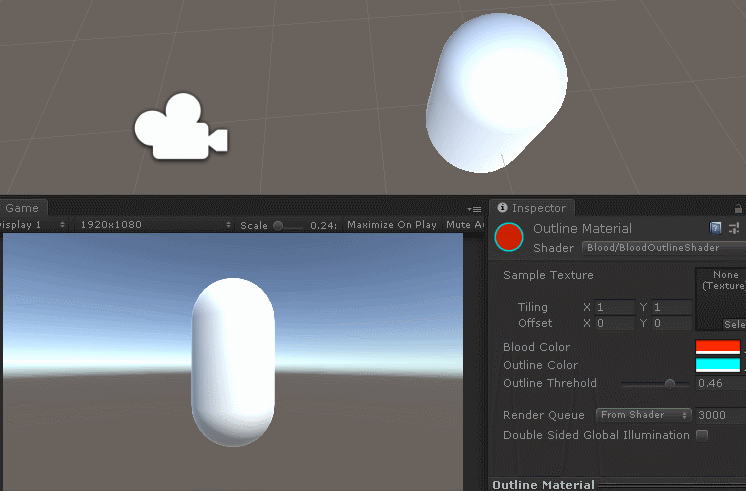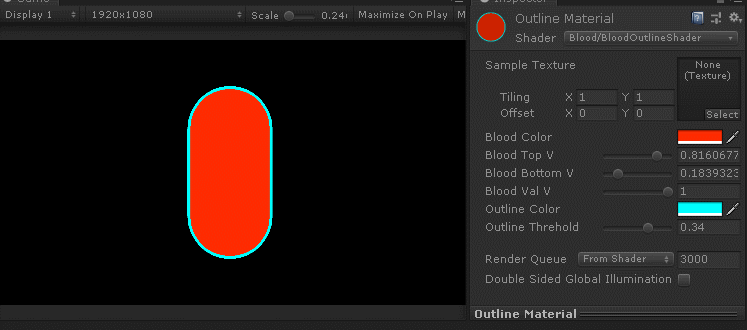C for Graphic:CommandBuffer血量图
最近618买了个机械师蓝牙游戏鼠标,日常使用几天感觉还行,就把CF安装了,每天玩两把试试身手。
CF每次结束游戏会弹出直播,直播是以主持人上帝视角(可切换人称视角)进行的, 其中有个shader效果很经典,基本上流行的大中型的FPS游戏都有使用:就是角色血量透视展示。
看到标注的红圈没?一个被遮挡的角色,只有一半血,显示效果就是一个高斯模糊外描边和根据血量的身躯填充色。这种shader效果因为其常用性,所以我们就来实现一下。当然实现起来也不难,依次分步骤实现:
1.commandbuffer外描边(或forwardbase透视外描边)
2.commandbuffer填充色(取屏幕rendertexture)
3.在rendertexture基础上做uv的V方向clip裁剪(根据血量0f-1f裁剪)
好,既然我们了解实现原理,下面就来实现,这里方便起见我直接把第一步和第二步的效果做在一个shader中:
Shader "Blood/BloodOutlineShader"
{
Properties
{
_SampleTex("Sample Texture",2D) = "white" {}
_BloodColor("Blood Color",Color) = (1,1,1,1)
_OutColor("Outline Color",Color) = (1,1,1,1)
_OutThred("Outline Threhold",Range(-1,1)) = 0
}
SubShader
{
Tags { "RenderType"="Transparent" "Queue"="Transparent" }
LOD 100
Pass
{
Blend SrcAlpha OneMinusSrcAlpha
CGPROGRAM
#pragma vertex vert
#pragma fragment frag
#include "UnityCG.cginc"
struct appdata
{
float4 vertex : POSITION;
};
struct v2f
{
float4 vertex : SV_POSITION;
};
float4 _BloodColor;
v2f vert (appdata v)
{
v2f o;
o.vertex = UnityObjectToClipPos(v.vertex);
return o;
}
fixed4 frag (v2f i) : SV_Target
{
fixed4 col = _BloodColor;
return col;
}
ENDCG
}
Pass
{
Blend SrcAlpha OneMinusSrcAlpha
CGPROGRAM
#pragma vertex vert
#pragma fragment frag
#include "UnityCG.cginc"
struct appdata
{
float4 vertex : POSITION;
float4 normal : NORMAL;
};
struct v2f
{
float4 vertex : SV_POSITION;
float3 worldP2V : TEXCOORD0;
float3 worldNM : TEXCOORD1;
};
float4 _OutColor;
float _OutThred;
v2f vert (appdata v)
{
v2f o;
o.vertex = UnityObjectToClipPos(v.vertex);
o.worldP2V = normalize(WorldSpaceViewDir(v.vertex));
o.worldNM = normalize(UnityObjectToWorldNormal(v.normal));
return o;
}
fixed4 frag (v2f i) : SV_Target
{
fixed4 col = _OutColor;
float wei = saturate(dot(i.worldP2V,i.worldNM));
wei = step(wei,_OutThred);
col.a = wei;
return col;
}
ENDCG
}
}
}
做个和以前不一样的效果,用step函数(step(a,b)意思就是如果a<=b,返回1,否则返回0)来裁剪渲染,则没有了渐变。
接下来要做的就是给这个shader第一个pass做一个V方向的裁剪,大家想一下怎么做这个V方向的裁剪呢?
我给个思路:我们已经获取了cylinder在屏幕空间的二维rendertexture(称CTex),但是这个CTex上下部还留有很大黑色像素区域,那么我们得获取这个cylinder的“头部”和“脚部”映射的屏幕空间位置A和B,以A和B作为CTex的V方向裁剪端点做裁剪。
关于怎么获取A和B端点,我们有以下做法:
1.通过cylinder的transform下绑定head transform和foot transform,然后通过c#函数映射
2.通过cylinder自身transform映射到屏幕空间,然后在CTex上做上下方向的像素递增扫描,获取AB端点像素
3.直接在CTex上做逐行列的像素扫描获取外接矩形
这里我建议使用第一种,因为第一种效率高,而且本身做游戏的时候,角色身上就需要绑定很多transform(比如角色头部的血条名称等需要一个head transform,角色脚底下的foot transform用来做脚底下的“假阴影”、“选中环”等效果)。
so,我们接下来改造shader,做一个血量显示的效果:
Shader "Blood/BloodOutlineShader"
{
Properties
{
_SampleTex("Sample Texture",2D) = "white" {}
_BloodColor("Blood Color",Color) = (1,1,1,1)
_BloodTop("Blood Top V",Range(0,1)) = 0
_BloodBottom("Blood Bottom V",Range(0,1)) = 0
_BloodVal("Blood Val V",Range(0,1)) = 0
_OutColor("Outline Color",Color) = (1,1,1,1)
_OutThred("Outline Threhold",Range(-1,1)) = 0
}
SubShader
{
Tags { "RenderType"="Transparent" "Queue"="Transparent" }
LOD 100
Pass
{
Blend SrcAlpha OneMinusSrcAlpha
CGPROGRAM
#pragma vertex vert
#pragma fragment frag
#include "UnityCG.cginc"
struct appdata
{
float4 vertex : POSITION;
float2 uv : TEXCOORD0;
};
struct v2f
{
float4 vertex : SV_POSITION;
float2 uv : TEXCOORD0;
};
sampler2D _SampleTex;
float4 _SampleTex_ST;
float4 _BloodColor;
float _BloodTop;
float _BloodBottom;
float _BloodVal;
v2f vert (appdata v)
{
v2f o;
o.vertex = UnityObjectToClipPos(v.vertex);
o.uv = TRANSFORM_TEX(v.uv,_SampleTex);
return o;
}
float mapv(float top,float bottom,float val)
{
float v = bottom + (top-bottom)*val;
return v;
}
fixed4 frag (v2f i) : SV_Target
{
fixed4 col = _BloodColor;
//float v = mapv(_BloodTop,_BloodBottom,i.uv.y);
float v = i.uv.y;
if(v > _BloodVal)
{
col.a = 0;
}
return col;
}
ENDCG
}
Pass
{
Blend SrcAlpha OneMinusSrcAlpha
CGPROGRAM
#pragma vertex vert
#pragma fragment frag
#include "UnityCG.cginc"
struct appdata
{
float4 vertex : POSITION;
float4 normal : NORMAL;
};
struct v2f
{
float4 vertex : SV_POSITION;
float3 worldP2V : TEXCOORD0;
float3 worldNM : TEXCOORD1;
};
float4 _OutColor;
float _OutThred;
v2f vert (appdata v)
{
v2f o;
o.vertex = UnityObjectToClipPos(v.vertex);
o.worldP2V = normalize(WorldSpaceViewDir(v.vertex));
o.worldNM = normalize(UnityObjectToWorldNormal(v.normal));
return o;
}
fixed4 frag (v2f i) : SV_Target
{
fixed4 col = _OutColor;
float wei = saturate(dot(i.worldP2V,i.worldNM));
wei = step(wei,_OutThred);
col.a = wei;
return col;
}
ENDCG
}
}
}
c#代码:
using System.Collections;
using System.Collections.Generic;
using UnityEngine;
using UnityEngine.Rendering;
public class CmdBufferBloodCamera : MonoBehaviour
{
public GameObject cmdCharacter;
public Material bloodMat;
private Transform characterHead;
private Transform characterFoot;
private RenderTexture bloodRT = null;
private CommandBuffer bloodBuffer = null;
void Start()
{
characterHead = cmdCharacter.transform.GetChild(0);
characterFoot = cmdCharacter.transform.GetChild(1);
}
private void OnEnable()
{
MeshRenderer render = cmdCharacter.GetComponent();
if (render != null)
{
bloodRT = RenderTexture.GetTemporary(Screen.width, Screen.height, 0, RenderTextureFormat.ARGB32);
bloodBuffer = new CommandBuffer();
bloodBuffer.SetRenderTarget(bloodRT);
bloodBuffer.ClearRenderTarget(true, true, Color.black);
bloodBuffer.DrawRenderer(render, bloodMat);
Camera.main.AddCommandBuffer(CameraEvent.AfterImageEffects, bloodBuffer);
}
}
private void OnDisable()
{
RenderTexture.ReleaseTemporary(bloodRT);
bloodRT = null;
Camera.main.RemoveCommandBuffer(CameraEvent.AfterImageEffects, bloodBuffer);
bloodBuffer.Clear();
bloodBuffer = null;
}
private void OnRenderImage(RenderTexture source, RenderTexture destination)
{
if (bloodBuffer != null)
{
Graphics.ExecuteCommandBuffer(bloodBuffer);
}
Graphics.Blit(bloodRT, destination);
}
private void Update()
{
Vector2 headPos = Camera.main.WorldToScreenPoint(characterHead.position);
Vector2 footPos = Camera.main.WorldToScreenPoint(characterFoot.position);
bloodMat.SetFloat("_BloodTop", headPos.y / Screen.height);
bloodMat.SetFloat("_BloodBottom", footPos.y / Screen.height);
}
}
哈哈哈哈,巨尴尬,等我代码写完测试发现,原来不需要映射Head Foot坐标,直接用BloodVal(0-1f)就行了,效果如下:
我的思维犯了个错误,我并不是用1920*1080的rendertexture作为sampler去做裁剪,而是在shader中使用渲染管线光栅化阶段后在屏幕上显示的纹理(pixelbuffer)作为sampler做裁剪,简单来说就是单纯的使用这个2D的cylinder图,所以省去了映射计算,相反更简单了。
最后我们写个混合shader将blood图和原始纹理混合就行了:
Shader "Blood/BloodBlendShader"
{
Properties
{
_SrcTex ("Source Tex", 2D) = "white" {}
_BloodTex ("Blood Tex", 2D) = "white" {}
}
SubShader
{
Tags { "RenderType"="Opaque" }
LOD 100
Pass
{
CGPROGRAM
#pragma vertex vert
#pragma fragment frag
#include "UnityCG.cginc"
struct appdata
{
float4 vertex : POSITION;
float2 uv : TEXCOORD0;
};
struct v2f
{
float2 uv : TEXCOORD0;
float4 vertex : SV_POSITION;
};
sampler2D _SrcTex;
float4 _SrcTex_ST;
sampler2D _BloodTex;
v2f vert (appdata v)
{
v2f o;
o.vertex = UnityObjectToClipPos(v.vertex);
o.uv = TRANSFORM_TEX(v.uv, _SrcTex);
return o;
}
fixed4 blend(float4 scol,float4 bcol)
{
fixed4 col = lerp(scol,bcol,bcol.a);
return col;
}
fixed4 frag (v2f i) : SV_Target
{
fixed4 scol = tex2D(_SrcTex, i.uv);
fixed4 bcol = tex2D(_BloodTex,i.uv);
fixed4 col = blend(scol,bcol);
return col;
}
ENDCG
}
}
}
c#改下OnRenderImage就行了:
private void OnRenderImage(RenderTexture source, RenderTexture destination)
{
if (bloodBuffer != null)
{
Graphics.ExecuteCommandBuffer(bloodBuffer);
}
blendMat.SetTexture("_SrcTex", source);
blendMat.SetTexture("_BloodTex", bloodRT);
Graphics.Blit(null, destination, blendMat);
}效果如下(我顺便加了个blood alpha变量):
当然CF中角色没有被遮挡就不需要显示Blood效果,我们直接在c#中用Invisible和Visible做添加移除Buffer操作就行了:
private void OnBecameVisible()
{
//移除gameobject到camera commandbuffer
}
private void OnBecameInvisible()
{
//添加gameobject到camera commandbuffer
}so,实现原理就是这个样子。




